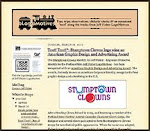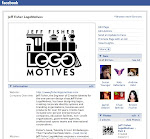Alice B. Theatre was founded in 1984 in conjunction with the first Gay and Lesbian Theatre Festival in Seattle. The theatre company name is a reference to Alice B. Toklas - the confidante, lover, cook, secretary, muse, editor, critic, and general organizer of writer Gertrude Stein. In 1933 Stein published her memoirs under the title The Autobiography of Alice B. Toklas. Toklas released her own book, The Alice B. Toklas Cookbook, in 1954. A memoir containing a collection of recipes, it is probably best known for its instructions on making cannabis brownies (which later played a role in the plot of the 1968 Peter Sellers movie I Love You, Alice B. Toklas). In old photos Toklas is often seen wearing a big floppy hat.
My workspace next door neighbor, Alice B. Theatre, made use of my design services in creating print ads, flyers, posters and other items for the live theatre performances presented in the local community. The one thing the group was lacking was a strong graphic identity. At some point I suggested to the organization's director that it might be worthwhile to put some time and energy into creating a logo for the group.
As my present day office cleaning attests, I began doodling my ideas for the image on just about any paper surface I came across. The first was a a pencil sketch on a page from a memo pad given to me from a printer in Lynnwood, WA. On a scrap torn off a yellow, lined legal notepad was another rough concept done in a think black felt pen. Yet another idea was executed in India ink on a piece of tracing paper. (Yes, I've saved these things for two decades!)
Each concept included a reference to the floppy hat once worn by Alice B. Toklas. Another common element was at least one evident triangle shape, creating a bow, as a symbolic tip of the hat to the primarily gay and lesbian target audience of the performing arts group. The font University Roman, which had been used on some previous theatre marketing and promotion materials, was the typeface given the most consideration throughout the process.
As I fine-tuned the concept from the legal tablet I decided the logo was a bit too flat, long and skinny. I felt as if the hat needed more weight and presence in the identity. The treatment of the font related back to my earliest doodle on the printing company memo sheet.
I've always liked the final logo design and the image it conveyed for the the theatre company. Unfortunately, I moved back to Portland before any kind of full-fledged branding effort could be introduced. According to documentation in the Special Collections of the University of Washington Libraries, Alice B. Theatre disbanded in the spring of 1996 and reorganized as Alice B. Arts in September 1996. It then ceased operations completely in 1997.
In reviewing the 20-year-old logo today, I might have designed one portion of the image differently. The big and small caps, used in the organization name, may have been replaced with the cleaner, more simple, all caps treatment displayed in the concept making use of the long, thin hat graphic. It always bugged me that the tagline was broken into two elements in my final design. It would have been read much more easily as one complete line under the Alice B. Theater name.
(This post originally appeared on bLog-oMotives.)
© 2008 Jeff Fisher LogoMotives




















